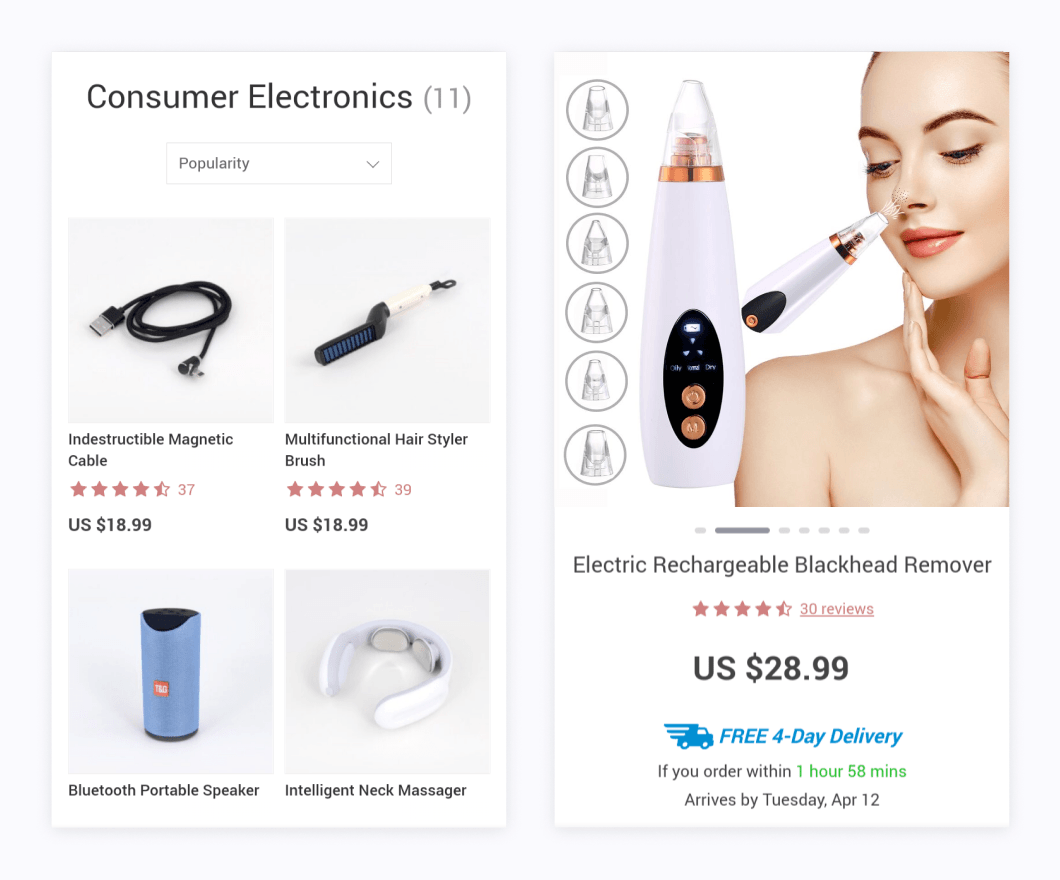What’s the key to a pleasant (and profitable!) ecommerce experience when you’re just starting out with no prior knowledge? Alexander, our today’s guest, was kind enough to share his personal ecommerce journey – and share plenty of tips for fellow newcomer entrepreneurs! Let’s welcome him!
Hi, please introduce yourself!
Buna ziua! My name’s Alexander Rooney and I’m from Romania, currently living in Nashville, Tennessee, USA. I am currently studying Graphic Design at Full Sail University. I love listening to music, rollerblading, and traveling!
How did you get interested in ecommerce?
After serving in the U.S. Army for 8 years, I decided to try out Ecommerce and Graphic Design. I decided I wanted more freedom in my life.

I have always had that entrepreneurial itch and dream to start my own business. So, I started researching different ways to start a business on a limited budget.
I first came across Shopify and researched the whole idea of dropshipping. Shopify was convenient in that you could create your online store, use their apps to add different features and products to your store, and manage everything on your cell phone. My ecommerce journey with Shopify began when I created multiple stores in various niches.
What can you say about this ecommerce experience?

It was pretty hard at the beginning. I watched hundreds of hours of YouTube videos on dropshipping to try and learn as much as I could.
At some point, I noticed that the majority of my customers were from the United States. This was a problem for me because I was using suppliers from China, so shipping across the globe was expensive and took forever. I ended up buying some winning products in bulk and then shipping them from my house to the customer once the order was made. It started to become overwhelming to house all of the products myself and then ship them out myself.
I was making money and losing money at the same time.
It was so costly in the end. Having to pay for the subscription, paying for all of the apps you need to edit and manage your store, and having to buy products in bulk in order to stay competitive with pricing and shipping. I thought there has to be a better way!
Finally, I stumbled upon Sellvia and was frustrated I hadn’t heard of it sooner. I wasn’t sure how Sellvia worked exactly and if they were actually going to give me what they said they would. So, I signed up and lo and behold, I received my custom-made store the next day! I was in love with the products offered, the fast shipping, and that it was U.S.-based. So, I decided to close down my Shopify stores and start a new journey with Sellvia.
How would you rate your Sellvia ecommerce experience?
As I said, I was searching for a better way to run my business. I needed a good supplier, fast U.S. shipping, and a beautiful website. Sellvia offers all of that and more!
Overall, I would rate Sellvia 10/10! They offer you all the tools you need to succeed. What more can you ask for? I’d like to continue my subscription with Sellvia and consider adding some of their different packages to my store, like SEO and Branding.
Sellvia has allowed me the opportunity to do the things I love and sustain a comfortable lifestyle. I was homeless for over a year until I started ecommerce and freelance graphic design work. Now I have my own apartment and I’m able to work 100% remotely now which has always been my dream. I love being my own boss and having the flexibility to do the things I want to do.
What kind of products are you selling?
I decided to sell Health and Beauty products supplied by Sellvia. I thought that if Eugène Schueller (a man) could own L’Oréal (a Health and Beauty brand), then so can I! To my mind, this was a great niche to get into because who doesn’t like looking good and feeling great?

How do you promote your ecommerce business?
Previously, I used various services to boost my stores’ SEO. I also created ads on Instagram and Facebook and used affiliate marketing to spread the word about my store and products. I asked local Tiktokers in my city to promote and review my products through their Tiktoks as well as contacted Instagram makeup influencers.
You don’t need to spend a fortune on marketing when you start off. Reach out to friends and family and ask them to help promote your store. Create business cards with your socials and website on it. Share them with people you run into in the community. I even walked around the mall and asked people to check out my store!
I have spent a small fortune trying to become financially successful. But over time I realized that personality and genuine human connection sells more than corporate marketing strategies.
Still, if you want some marketing insights on how to actually start selling – here they are, taken from my personal ecommerce experience!
#1 Find your niche
This one’s easy! Look at the Sellvia catalog and choose which niche is closely related to your own interests. For example, if you’re a car freak, then center your store around Auto Parts and Accessories. Or, if you like animals, then just get a pet-oriented shop.
Choosing a niche that you are interested in personally rather than picking what you think will sell best will greatly improve your success in the future. It’s all because you can relate to these niches on a personal level and people are more willing to purchase your products when they feel a personal connection to it.
#2 Do not create a store with every Sellvia product in it – stick to one niche only
If you have too many products in your store that vary, your potential customers will get distracted and or not understand exactly what your company is about.
#3 Consider social media branding
Okay cool, you picked your niche! Now let’s focus on building a fan base for your company! First thing is you need to create an Instagram account and Facebook page for your company. Make sure the name matches across all platforms so that it’s easier to find you.
#4 Grow your presence
Time to create your first post! I suggest posting an image of your logo or store name and writing a friendly introduction about your store and the products you sell.
#5 Work on engagement
Here’s where things get juicy! Now, first things first. I know that Sellvia offers amazing marketing materials for its products. However, you should not use these materials for your everyday post. I will tell you when to use them on the next step. So, what should you post instead?
Remember when I told you that you should pick a niche you’re actually interested in? Well, that’s where your knowledge and passion comes into play! For example, if you’re running a car accessories store, create engaging posts where you talk about car safety and the importance of hands-free driving. Talk about statistics on how many vehicle accidents occur due to someone handling their phone on the road. Share some free stock images related to your post (not product images!). Ask your followers to like or comment below if they have ever been in an accident. When you ask your followers to interact with your page that is called a “Call to Action”. This is very important when it comes to growing your social media account. This helps let the Facebook/Instagram algorithm know that you post engaging content and that it should share your posts with more people.
I have developed a proven Content to Product posts ratio that you can use.
Post one engaging product post for every 4 content-related posts specific to your niche.
You don’t own a Fortune 500 company yet so people don’t want to scroll down your feed and only see product posts. You need to engage your audience by posting relatable content.
Also, you should create reels for Instagram. This will bring in tons of followers. Plus, use Instagram stories and vote buttons to increase engagement and use the algorithm to your advantage.
#6 Invest in paid marketing
You get what you pay for! So, you’ve used the 1 to 4 ratio and you have gained a few followers. Now, it’s time to really push your products out there for everyone to see!
At that point, you can either use Sellvia’s free marketing materials or create your own designs on Canva. Once you decide on what photo or video to use, write a captivating caption for your post.
Do not use any hashtags: you can’t use hashtags on Promoted Ads.
Next, after you posted your ad, you can tap the Promote button. You need to allow Instagram to choose who to show your ads to. I suggest putting up the budget of $10 for your first promoted ad.
What a detailed strategy! Any more tips for fellow entrepreneurs to boost their ecommerce experience?
I learned that there are 5 keys to running a successful ecommerce business.
Number one, you need to find a specific niche for your products.
Two, you need to find high-quality products in your niche.
Three, you need to have competitive prices and fast shipping.
Four, you need to create a beautiful website and social media for your store.
Five, you need to focus more on building a community based around your products rather than selling your products.
These are simple yet crucially important steps everyone must take in order to achieve financial freedom through dropshipping.
What are your plans for the future?
I believe Sellvia will be a part of my life for a long time to come. I’m thinking of launching yet another ecommerce store with car accessories and supplies.
Also, I am interested in applying for the Sellvia affiliate program as well in the near future. I love helping people find financial freedom in their lives and I love Sellvia. So I decided to put the two together! I have a travel page with 90k followers on it. The plan is to start posting travel vlogs after I graduate from college and talk about how dropshipping has enabled me to travel full time around the world.
In terms of affiliate efforts, my promotional method is going to be rather simple. I’ve already started reaching out to friends and family and talking to them about my ecommerce experience with Sellvia. I give them an unbiased opinion and let them decide whether or not Sellvia is right for them.
What a fascinating story! We are beyond grateful to Alexander for sharing his ecommerce experience with Sellvia blog readers – there’s so much to learn from his dropshipping journey! Isn’t his example an inspiration for everyone willing to try themselves as online business owners, too?





